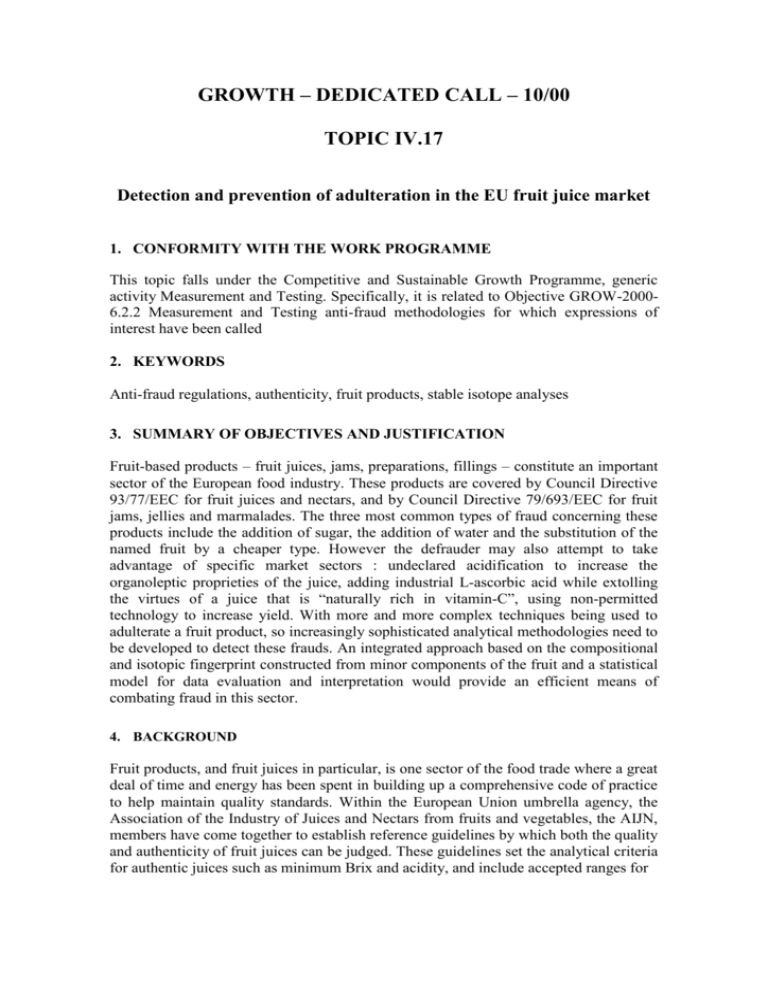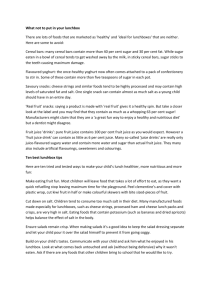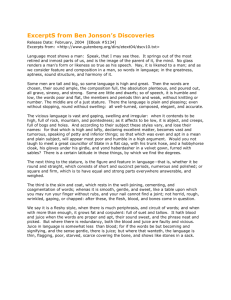MS Word - CORDIS
advertisement

GROWTH – DEDICATED CALL – 10/00 TOPIC IV.17 Detection and prevention of adulteration in the EU fruit juice market 1. CONFORMITY WITH THE WORK PROGRAMME This topic falls under the Competitive and Sustainable Growth Programme, generic activity Measurement and Testing. Specifically, it is related to Objective GROW-20006.2.2 Measurement and Testing anti-fraud methodologies for which expressions of interest have been called 2. KEYWORDS Anti-fraud regulations, authenticity, fruit products, stable isotope analyses 3. SUMMARY OF OBJECTIVES AND JUSTIFICATION Fruit-based products – fruit juices, jams, preparations, fillings – constitute an important sector of the European food industry. These products are covered by Council Directive 93/77/EEC for fruit juices and nectars, and by Council Directive 79/693/EEC for fruit jams, jellies and marmalades. The three most common types of fraud concerning these products include the addition of sugar, the addition of water and the substitution of the named fruit by a cheaper type. However the defrauder may also attempt to take advantage of specific market sectors : undeclared acidification to increase the organoleptic proprieties of the juice, adding industrial L-ascorbic acid while extolling the virtues of a juice that is “naturally rich in vitamin-C”, using non-permitted technology to increase yield. With more and more complex techniques being used to adulterate a fruit product, so increasingly sophisticated analytical methodologies need to be developed to detect these frauds. An integrated approach based on the compositional and isotopic fingerprint constructed from minor components of the fruit and a statistical model for data evaluation and interpretation would provide an efficient means of combating fraud in this sector. 4. BACKGROUND Fruit products, and fruit juices in particular, is one sector of the food trade where a great deal of time and energy has been spent in building up a comprehensive code of practice to help maintain quality standards. Within the European Union umbrella agency, the Association of the Industry of Juices and Nectars from fruits and vegetables, the AIJN, members have come together to establish reference guidelines by which both the quality and authenticity of fruit juices can be judged. These guidelines set the analytical criteria for authentic juices such as minimum Brix and acidity, and include accepted ranges for DC 10/00/Topic IV.17/ Pg 2 organic acids, mineral content, sugars, amino acids, and a number of other parameters. Values largely reflect the commercial standards which have existed for a number of years in countries such as France, Germany, and the Netherlands. Of these the most widely used are the German Fruit Juice Industry guide values, known as the RSK values, introduced in the late 70's and early 80's. Using this system, a fruit juice sample is subjected to a long list of chemical analyses. Its authenticity is then assessed taking into account the entire analytical picture. Since deviations from the standard ranges may indicate adulteration in certain cases or result from poor processing techniques in others, expert interpretation is required. Measuring a number of these basic compositional parameters - sugars, organic acids, mineral content - can pick up gross adulterations, although more subtile frauds are easily masked by adding the right quantities of chemical compounds to bring the parameters back within the published range. The most common type of fraud is the addition of sugar to the juice or juice concentrate to increase the soluble solids content. Since a juice concentrate is sold on the basis of its soluble solids content, and since sugar syrups are cheaper than the juice concentrate, there is a temptation for the unscrupulous producer to take advantage and add sugar to increase his gain. One obvious means of concealing added sugar is to increase acidity with added organic acids. Several years ago crude commercial malic acid was used that contained both Dand L- forms of the acid, and was fairly simple to detect once industry had been alerted to the problem - pure fruit juices only contain the L-form. Now pure L-malic acid is available on the market that also contains no other markers such as fumaric acid making detection impossible. Another use for added malic acid came to light recently as the defrauders attempted to take advantage of a huge price difference between low and high acid apple concentrate (see section 5 below). Another minor acid, the authenticity of which has also been called into question, is Lascorbic acid (vitamin C). Because of its importance in a well-balanced diet, the vitamin C content of citrus juices is often used as a major marketing tool. Expensive manufacturing technology is required to preserve natural L-ascorbic acid from degradation during industrial processing and there is concern from both the industry and the regulatory bodies that some producers may try and cut costs by using cheaper technology and adding industrially-produced ascorbic acid to replace the lost vitamin C. Although this is not forbidden, the added L-ascorbic acid should be mentioned product label. Since this would not be compatible with a ‘naturally-high vitamin C content’ advertising slogan, there is a temptation to leave it out of the ingredients list. In Council Directive 93/77/EEC of 21 September 1993, fruit juice is defined as “the juice obtained from fruit by mechanical processes, fermentable but unfermented, having the characteristic colour, aroma and flavour typical of the fruits from which it comes”. In particular only certain processing acids or treatments are permitted. Yields of citrus fruit that are processed according to the EU Fruit Juice Directive are normally below 45%. One way of increasing output would be to process the peel and pulp which is not allowed. Existing methodologies for fruit juice analysis have made considerable inroads into detecting adulterated products. However as the defrauder is becoming more sophisticated both in the type of fraud perpetrated and in the ways used to cover it up, so the analyst must research further into the product itself to look at the minor components DC 10/00/Topic IV.17/ Pg 3 present. Such compounds may be minor constituents of the fruit itself, or trace impurities from non-permitted additives or processes. In some cases the presence of the compound detected by chromatographic or other techniques, will itself be sufficient to declare the product adulterated. In others, for example the addition of industrial malic acid to a fruit that naturally contains the same acid, the differentiation between the endogenous and exogenous compound will require further investigation. Isotopic methods based on the determination of isotope ratios by mass spectrometry and nuclear magnetic resonance are possibly the most efficient techniques to date to detect whether a component in the juice sample (sugars, acids) actually come from the fruit. Each plant has its own unique pattern of naturally occurring stable isotopes of carbon (13C), hydrogen (Deuterium) and oxygen (18O), whose distribution has been influenced by a number of physical and/or biochemical processes. This results in measurable differences in the isotope content in natural products depending on their botanical, and in some cases, geographical origin. In practice, H/D ratios measured on the ethanol obtained from the fermentation of the sugars can be used to detect beet-derived sugars, whereas 13C/12C ratios will indicate whether sugars and/or sweeteners from a cane or corn source have been added. These methods are now well established and have been collaboratively tested both in Europe (European Committee for Normalisation, CEN) and internationally (Office International de la Vigne et du Vin, OIV, and the Association of Official Analytical Chemists, AOAC). The official laboratories of France, Germany, the UK, Spain, Portugal and Italy all have access to the dedicated equipment required to carry out isotopic analyses. The advantage of isotopic techniques is that it is not possible to change the isotopic ratios of the sugars to hide their addition. On the other hand the natural variation of isotopic values within the same fruit type means that it is difficult to improve on a 10% detection limit by measuring only one constituent of the juice. The potential of stable isotope techniques to detect economic adulteration is considerably improved by carrying out the determination on several components of the same product and investigating their intermolecular isotopic correlation. It has been shown that specific correlations exist between the 13C value of different metabolites of a fruit – organic acids, sugars, and so on – and that any deviation from the expected correlation is indicative of the addition of a least one of these compounds from a exogenous source. This internal standard approach has been successfully used for detecting adulteration of honeys. Further development is required to extend this approach to the measurement of other isotopes (15N, 2H, 18O) and to further examine the 13C content of the minor trace components. This should be included in an integrated approach based on the construction of isotopic and compositional profiles of minor components in the fruit product. This information should be obtained on a defined number of reference authentic samples of the most important fruit types and a statistical model for data evaluation and interpretation developed. This approach would be valuable not only for checking the authenticity of fruit juices but also all fruit related products such as jams, preserves, fruit preparations, fillings and so on. These specific cases and the most common fruit types used in these products should be included in the project DC 10/00/Topic IV.17/ Pg 4 5. ECONOMIC AND SOCIAL BENEFITS Fruit juices and nectars are an important and fast growing sector of the food industry. Over the last ten years total per-capita consumption in Europe has doubled from 10.4 litres in 1985 to 22.1 litres in 1997. In the USA over the same period, consumption has risen from 25.1 to 30.0 litres per inhabitant. Although the trend has been less noticeable in the traditional juice and nectar markets such as Germany and Sweden, the increase has been spectacular in countries such as France, where annual per-capita consumption has risen from 8.3 litres in 1990 to 18.0 litres in 19971. One of the driving factors behind this increase is the ‘healthy’ and ‘natural’ images that are associated with consuming fruit juice. In the United States, Florida orange juice has the backing of the American Cancer Society, and all 100% Florida orange juice products carry the mention “Fight Cancer. Drink more Florida Orange Juice”. More traditionally, fruit juice has been recommended by paediatricians to provide extra free water for normal infants and young children. Since they taste good, children readily accept them, and as they are “natural”, they are perceived as offering more nutritional benefit than just an increase in water intake. Per-capita consumption in litres 45 40 35 1990 30 1995 1997 25 20 15 10 5 Portugal Italy Greece Ireland Spain France Denmark Sweden United Kingdom Finland Belgium Austria Netherlands Germany 0 Figure 1 : Trends in fruit juice and nectar consumption in the European Union 19901997 A further driving force for the global increase in fruit juice consumption is the emergence of new markets, in South and Central America, in Asia and most particularly in the ex-Eastern block countries. On the other hand, production does not necessarily follow. As a natural product, fruit and fruit juice is subject to problems of poor climatic conditions, crop disease as any other agricultural product. Currently the market for apple juice is under great pressure due to poor harvests two years running and a severe shortage of high-acid apple, generally preferred by consumers. The current price difference between both types of 1 Facts, figures, information. A.I.J.N. Association of the Industry of Juices and Nectars from Fruits and Vegetables of the European Union. DC 10/00/Topic IV.17/ Pg 5 apple juice concentrate is about 2 to 1 in favour of high acid. IT was recently calculated that apple juice concentrate adulterated with sugar and acid and coming from just one company created an illegal commercial advantage of 2.1 Mio DM. The Association for the German fruit juice industry recently issued a warning for members buying apple juice concentrate to be on their guard against illegal production and trading practices. In April 2000, the European Quality Control Scheme (EQCS) was informed of several instances of adulterated apple juice. Pineapple juice concentrate is another commodity subject to price fluctuations and with high prices forecast for the coming season, the industry and regulators are on the lookout for potential problems. With disease currently rife in the orange groves of Brazil, the world’s largest producer of orange juice concentrate, there is also potential situation there for wide-scale adulteration. What is required is a highly proactive approach based on a comprehensive data base of isotopic and compositional parameters that can be used both to detect adulterated products as soon as they appear on the market and even to dissuade the defrauders before they begin. The adulteration of fruit juice, as with other food products, disrupts the market, prevents fair competition and results in the loss of consumer confidence. There is the urgent need to develop increasingly sophisticated techniques, that cannot be easily circumvented, to keep one step ahead of the adulterators. There is a direct request from industry, and in particular from the European Quality Control Scheme, an umbrella organisation bringing together the national quality control schemes of the different EU Member States, to have such a tool available in order to detect problems in the market as early as possible in order to avoid potential to the industry’s image 6. SCIENTIFIC AND TECHNOLOGICAL OBJECTIVES The scientific and technological objectives of the project should be as follows : To carry out an extensive literature search to compile a review of existing analytical methods and parameters on minor components of fruit juice To investigate the different types of technology available and their effects on composition To further develop the analytical methods where required in order to improve the quantification of a marker compound (for example : sugar alcohols as a marker for citrus processing technology) or to optimise the separation procedure to obtain pure compound for isotopic analyses To develop and optimise stable isotope methodology, using isotope ratio measurements by both nuclear magnetic resonance and dedicated mass spectrometry, to enable the detection of artificially added compounds in fruit juices To construct an isotopic fingerprint of fruit juice products from individual isotope contents (13C, 2H, 15N, 18O) of the juice components (eg. proteins, phenolic compounds, trace oligosaccharides) DC 10/00/Topic IV.17/ Pg 6 To investigate the extent and nature of the correlation between the isotopic profile of the various components and the effect on this correlation of the addition of a nonjuice compound or component from a different juice type To identify the combinations of quantitative compositional and specific isotopic data that will allow the verification of fruit juice labels with respect to their origin and their ingredients. To provide a integrated statistical approach to enable the correct evaluation and interpretation of isotopic data in detecting fraudulent fruit juices To guarantee the necessary inter-comparability of isotopic methods or alternative techniques proposed between European laboratories and establish a technology transfer strategy to ensure that these methods are widely available and applicable. 7. TIME SCALE Although no rigid timescale requirements apply to this project, a period of 3 years is considered as being realistic to conduct such a project. 8. IMPORTANT ADDITIONAL INFORMATION Close collaboration with control laboratories is highly recommended REFERENCES 1. J. Bricout, J. Koziet (1987) Control of the authenticity of orange juice by isotopic analysis. J. Agric. Food Chem. 35, 758-760. 2. L.W. Doner, H.O. Ajie, L.D. Sternberg, J.M. Milvurn, M.J. DeNiro, K.B. Hicks (1987) Detecting sugarbeet syrups in orange juice by D/H and 18O/16O analysis of sucrose. J. Agric. Food Chem. 35, 610-612. 3. A. Rossmann, W. Rieth, H.-L. Schmidt (1990) Möglichkeiten und Ergebnisse der Kombination von Messungen der Verh„Itnisse stabiler Wasserstoff- und Kohlenstoff-Isotope mit Resultaten konventioneller Analysen (RSK-Werte) zum Nachweis des Zuckerzusatzes zu Fruchsäften. Z. Lebensm. Unters. Forsch., 191, 259-264. 4. G.G. Martin, V. Hanote, M. Lees, Y.L. Martin (1996) Interpretation of combined 2H SNIF-NMR and 13C SIRA MS analyses of fruit juices to detect added sugar. J. AOAC Int. 79 (1), 62-72. 5. G.G. Martin, R. Wood, G.J. Martin (1996) Detection of added beet sugar in concentrated and single strength fruit juices by Deuterium Nuclear Magnetic Resonance (SNIF-NMR method) : Collaborative Study. J. AOAC Int. 79 (4), 917928. 6. M. Gensler, A. Rossmann, H.-L. Schmidt (1997) Metabolic and isotopic correlations between D-glucose, L-ascorbic acid and L-tartaric acid. Isotopes Environm. Health Stud. 33, 151-155. 7. N.H. Low (1997) Food authenticity analysis by high performance anion exchange chromatography with pulsed amperometric detection. Seminars in Food Analysis 2, no 1/2, 55-70. DC 10/00/Topic IV.17/ Pg 7 8. A. Trotzer,, H.-J. Hofsommer and K. Rubach (1994) Kohlenhydratanalytik mit Anionenaustausch-chromatografie und gepulster Detektion am Dionex DX-300 Chromatographie Modul Flüssiges Obst, 61 (12), 581-589. 9. H.-J. Hofsommer, S. Koswig (1999) New analytical techniques for judging the authenticity of fruit juices – An overview. Fruit Processing, 12, 471-479.






